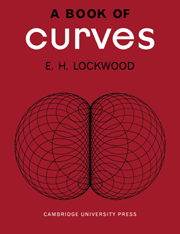Book contents
- Frontmatter
- Contents
- Dedication
- PREFACE
- HISTORICAL INTRODUCTION
- NOTATION
- PART I SPECIAL CURVES
- PART II WAYS OF FINDING NEW CURVES
- 14 Conchoids
- 15 Cissoids
- 16 Strophoids
- 17 Roulettes
- 18 Pedal Curves
- 19 Negative Pedals
- 20 Glissettes
- 21 Evolutes and Involutes
- 22 Spirals
- 23 Inversion
- 24 Caustic Curves
- 25 Bipolar Coordinates
- FURTHER READING
- GLOSSARY
- INDEX OF NAMES
- INDEX OF SUBJECTS
21 - Evolutes and Involutes
Published online by Cambridge University Press: 07 May 2010
- Frontmatter
- Contents
- Dedication
- PREFACE
- HISTORICAL INTRODUCTION
- NOTATION
- PART I SPECIAL CURVES
- PART II WAYS OF FINDING NEW CURVES
- 14 Conchoids
- 15 Cissoids
- 16 Strophoids
- 17 Roulettes
- 18 Pedal Curves
- 19 Negative Pedals
- 20 Glissettes
- 21 Evolutes and Involutes
- 22 Spirals
- 23 Inversion
- 24 Caustic Curves
- 25 Bipolar Coordinates
- FURTHER READING
- GLOSSARY
- INDEX OF NAMES
- INDEX OF SUBJECTS
Summary
Definitions
If the normals at points Q and q of a curve meet at C, then the limiting position of C, as q approaches Q, is called the centre of curvature of the curve at Q.
The locus of the centre of curvature, as Q varies on the curve, is called the evolute of the curve. The original curve is called an involute of the new one.
The evolute may alternatively be defined as the envelope of the normal to the curve; for C lies on two tangents to this envelope and, as they approach coincidence, the limiting position of C is a point on the envelope.
Examples of Evolutes
Many examples have already been given, such as the evolute of the parabola (Fig. 1) and that of the cycloid (Fig. 57). It has been shown (p. 105) that the evolute of an equiangular spiral is an equal spiral; and the evolute of any hypocycloid (p. 145) or epicycloid is a curve similar to the original.
Drawing of Evolutes
In the drawing of evolutes it is a help to know that the evolute passes through any ordinary cusp–point of the original curve; that points of inflexion on the original curve correspond to points at infinity on the evolute; and that points of maximum or minimum curvature correspond to cusps of the evolute. (See Fig. 103.)
- Type
- Chapter
- Information
- Book of Curves , pp. 167 - 172Publisher: Cambridge University PressPrint publication year: 1961
- 1
- Cited by



